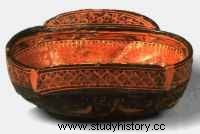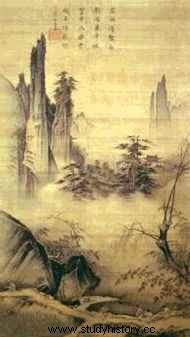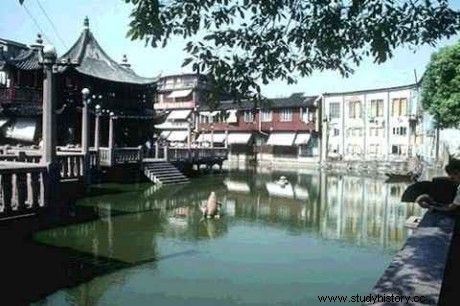Introduction
art and architecture of China from the Stone Age to the 20th century, which represents the most significant achievements of the world's oldest civilization. The fundamental principle of all aspects of Chinese culture is harmonious balance, and thus their art is a subtle mixture of traditions and innovations, of indigenous and foreign ideas, of secular and religious images.
Historical Development
Chinese emperors were the first and most assiduous artistic patrons. Many artists and architects were government employees who worked for royal duties. In contrast, aficionado artists, who in many cases were retired or exiled officials, could work without the limitations imposed by the court and their works reflected an important individualism, jettisoned from imperial styles. The accession to the throne or the defeat of the different royal houses profoundly affected the development of art in China, but they all shared an interest in maintaining tradition. Rulers, especially those establishing a new dynasty, were eager to confirm themselves in the eyes of their subjects, and the best way to gain their support was to build on the artistic achievements of previous dynasties. The court also accepted the new currents from India and the Middle East, but took care to weave any innovative ideas in the field of art, religion and philosophy into the already existing fabric of Chinese life.
Shang Dynasty
The Shang civilization (c. 1480-1050 BC) was born directly from the development that took place during the Neolithic period (4000-2000 BC), an important time in Chinese history. In this period, with the beginning of agriculture and the domestication of animals, people began to settle. With this new system of life, the oldest known funeral rites began. The objects of everyday use were buried with the deceased and, thanks to this, they have reached us in good condition. Neolithic tombs have revealed a great variety of pottery, especially large painted vessels, probably funerary urns, and cups of polished black clay, made on the lathe and perhaps used in some ritual.
In 1975, Chinese archaeologists working in the Anyang region discovered the tomb of a Shang king's favorite wife, where they found more than 400 bronze vessels and weapons, as well as 600 pieces of jade and stone. The great artistic quality of these objects, among which there were jade and bronze figures beautifully carved with the shapes of animals and birds, is evidence of the development of Chinese art belonging to the first dynasty.
Chou Dynasty
The Shang kings could not control the growing power of the neighboring tribe, the Chou (c. 1027-256 BC), established on their western frontier. It was in the year 1027 BC. that the Chou conquered Anyang and established their dynasty in the city. The art of the later Eastern Chou period shows the diversity and technical quality characteristic of the entire history of Chinese art. In the tombs of the Eastern Chou dynasty, paintings on silk were discovered, which are the oldest examples of this technique, as well as wood carvings and works in lacquer and glazed ceramics that speak of new technical developments and artistic styles.
Quin and Han Dynasties and the 6 Dynasties
The Quin dynasty played an important role in Chinese history, despite its brevity (221-206 BC). The political weakening of the eastern Chou empire ended with the consolidation of power by Emperor Quin Shi Huangdi, from whom the name China comes. After his death, this powerful ruler was buried in the north-western province of Shanxi, in a massive burial tomb that was recently discovered. In this royal tomb appeared more than 6,000 terracotta figures (among men and horses), destined to protect the crypt. They represent one of the Emperor's regiments, made up of perfectly equipped officers, charioteers, archers and young foot soldiers. The army was painted in a wide range of bright colors, which, over time, faded.

This vessel c The ear, so called for the shape of its wings, was made in China during the Han dynasty (206 BC -200 AD). On the outside, it is made of wood lacquered in black with red accents and, on the inside, in red with black and gold accents. It is possible that it formed part of the funerary goods that were buried with the dead
Started at the end of the Chou dynasty, the art of painting flourished during the Han period. The most frequent themes were episodes of life in the afterlife and legends of ancient heroes. These paintings reveal an evident intention to represent space and distance. Also during this period appeared the first elements of representation of the landscape.
The wealth of the Han court could not prevent the downfall of the dynasty in 220 BC. The centuries that followed, during which rival clans sought to control parts of the Empire, are known as the Six Dynasties period (220 BC-589 AD). During this period, art was influenced by new ideas and important religious developments, such as Confucianism and Taoism, which provided new themes and styles. Buddhism, arriving in China from neighboring India, had a profound effect on the art of the Six Dynasties period. The first examples of Buddhist art that came from China were the figurines carried by Indian Buddhists. In the 4th century, the confluence of styles and themes produced a new category of Buddhist art and architecture within the Chinese tradition. In Western China, however, important wall paintings based on sacred stories can be seen in the monastery of Dun-huang.
An important contribution to the architecture of the period was the wooden pagoda, based on the Indian stupa, in the Han dynasty tower. In the sixth century, virtually every facet of Chinese cultural life was inspired by Buddhism.
While Buddhist art dominated nearly all the works of the Six Dynasties, a shift in secular traditions was also taking place. To this period belongs Gu Kaizhi, considered the father of landscape painting. There was also progress in the field of ceramics. The first recognizable vases, called Yue-yao, are made of green glazed stoneware and were made on lathes in Zhejiang Province. This ceramic was very durable and used, above all, in the manufacture of gourds and jars that were exported to places as far away as the Philippines and Egypt.
Tang Dynasty
The Tang dynasty (618-907) provided a great artistic development, this period being known as the Golden Age of China. The country had been consolidated, firstly during the brief term of the Sui dynasty (589-618) and, secondly, in a more secure way, by the young monarch Taizong, in the year 618. The stability of the government and the consequent economic prosperity provided a flourishing of all artistic manifestations:painting, ceramics, music, poetry and metal crafts. Buddhists suffered periods of persecution during the Tang era, but in Chinese art, the influence of their religion endured. Buddhist painting maintained its importance during the Tang period, but the profane landscape came to dominate the pictorial arts. There are three well-known painters of that time:Wang Wei, creator of the monochromatic landscape, who preferred snowy landscapes, full of intimacy and calm melancholy; and, in contrast to his style, Li Sixun and his son Li Zhaodao (active 670-735), of markedly monumental character.
During this period, portrait painting, begun in the Han era, was perfected. Innovation is the main feature of the Tang period in relation to the decorative arts. Traders and artisans of different nationalities brought important influences from the Middle East, which stimulated the creation of new styles in metals and ceramics. The travel flasks and the gold and silver plates, in a wide variety of shapes, recall the traditions of Central Asia. The eye-catching earthenware jugs, especially vases and drinking vessels, made from metal prototypes, are very reminiscent of Persian goldsmiths. Ceramics from this period are important because, thanks to a technique developed in southern China, it was possible to cook a white, fine-grained substance, which is now known as porcelain.
Song Dynasty
In the years following the fall of the Tang government, China's territory was reduced as a result of invasions by neighboring peoples. The Song emperors (960-1270) were not as powerful as their Han and Tang predecessors. They struggled to maintain a shaky peace with their often hostile neighbors, and the arts of the time denote an introspection and refinement cultivated in response to harsh political reality. The Song emperors were characterized by erudition and many of them were even consummate artists. The painting of this period, abundant in schools and styles, is often referred to as the greatest achievement of Song art. A royal academy of painting was founded and the court itself sponsored numerous artists.
During this period (960-1126), painters leaned towards a monumental style, creating impressive panoramas. Artists such as Li Cheng, master of horizontal and distant planes (active in the 10th century), and Fan Kuan, who faithfully followed nature (active in the early 11th century), highlighted this style with their imposing views of rocky cliffs, interrupted by some waterfall or by some group of small figures.
In the 12th century, the imperial painting academy created a landscape style known as the Ma-Xia school, after the name of its main representatives:Ma Yuan and Xia Gui. They created less elaborate landscapes, using shadows to suggest the land mass and to give the work a light and ethereal look.
Pottery from the northern and southern Song periods is comparable to landscape painting in variety and achievement.
Song's tendency towards refinement can also be appreciated with regard to the architecture of the period. Tang styles were lengthening and thinning and gave way to needles characteristic of the Song style. The curved roofs, typical of Chinese architecture, reached their zenith in this period.
Yuan Dynasty
The invasion of the Mongols (1279-1368) produced changes in the nature of Chinese art, especially in painting and sculpture. Although foreign rulers had an interest in perpetuating classical Chinese culture, most artists were not happy at court and withdrew. Painting and calligraphy became activities of these former employees. Wenren hua, the art of independent aristocrats during the Song dynasty, was, during the Yuan period and beyond, the most important artistic school; they continued to be known as the scholars and despised the painters who joined the academy of conservatives and the imitators.

Painting by Chinese artist Ma Yuan (13th century), the most important painter of the Northern Song dynasty. This artist was known as "Ma, the one from a corner" because, in his paintings, he only reached one corner of the canvas, leaving the rest of the frame blank
In addition to the considerable difference in style, the brushwork of the Weren painters was sharper and more confident than that of the Southern Song artists. Rocks and trees, which in the Ma-Xia school are diffused, appear strongly in the work of Yuan painters. The mist is no longer used to suggest distance and infinity, and amplitude gives way to a more dramatic interest in form. Huang Gong-wang, Ni Zan, Wu Zhen and Wang Meng represent the characteristic diversity of this period.
From pre-Tang times calligraphy was considered a branch of painting. Along with poetry and music, it formed an important part of the knights' intellectual training. Calligraphy, like painting, shows the almost infinite possibilities of the brush. The Mongol court made great strides in porcelain making techniques. In the middle of the 14th century, the first closed displays were made of porcelain decorated with colors applied before vitrified.
The Mongols also made important inroads into the field of architecture. Today, the original structures in the Mongolian capital, Beijing, are believed to have been larger than the Ming structures that replaced them.
Ming Dynasty
Mongol rule ended with the establishment of the Chinese Ming dynasty, which lasted from 1368 to 1644. The court immediately founded the royal academy of painting, which attracted mainly bird and flower painters and landscape designers from the school. Ma-Xia. From the group that led the wenren Ming, called the Wu school, came numerous important artists, including Shen Chou and Wen Zengming. Shen Chou's brushwork denotes a rigorous line, which lends clarity to his works, often inspired by everyday themes, such as a group looking at the moon from a terrace. Wen Zengming preferred subjects of great simplicity, such as a tree or a rock, and his work conveys the strength that comes from solitude, perhaps as a reflection of his disenchantment with court life.
The Ming period is famous for its decorative arts. A new technique was introduced:once the porcelain had been vitrified and fired at the required temperature, the piece was painted with enamel of the desired color and it was returned to the oven a second time. Thanks to this invention, the finest Chinese pottery could be decorated with an infinite variety of brilliant colors.
Oing Dynasty
The last years of the Ming dynasty were marked by great internal political dissent. This situation was observed by neighboring Dongbei Pingyuan or Manchuria. A dynasty from this region, the Qing, taking advantage of the revolts, rose to power in 1644 and remained there until 1912. Eager to assimilate the traditions of previous dynasties, the Qing rulers embraced all aspects of Chinese culture.
The court continued to sponsor a royal academy of painting, but the quality of its output did not go beyond good imitation of Song styles.
The Buddhist monk Kun Can worked like the Zen painters of the southern Song period. Many of his figures are distorted, though not abstract, and his swiftly executed birds and rocks retain their organic form.
The decorative arts of the Qing period denote more technique than beauty. The enameling process was perfected during this time.
The ornamental styles favored in the Ming era were followed by Qing artists in metalwork, lacquer and jade carving. They were unique in their painstaking work with blown crystal. Wooden furniture decorated with lacquer, sometimes gilded, was widely accepted at the imperial court and among wealthy officials and merchants.
In architecture, too, many of the Ming traditions continued. The Mongols had rejected the delicate Song style, starting a trend towards lower, massive structures, which had been adopted by the Ming architects, creators of many rectangular buildings. The Ming temples have retained some Song details, such as the colorfully painted wooden figures inside. Qing emperors, on the other hand, preferred spacious, almost monotonous interiors, devoid of details. The palaces, many of which still exist in the city of Beijing, are the hallmark of Qing architecture and are characterized by massive forms, built in strict symmetry. Color plays an important role in these golden-roofed buildings, with red-painted accents and white marble stairs.

In the picture, a canal crosses a tearoom (left) in the old quarter
Shanghai originated approximately 5,000 years ago with a small fishing village. The city grew until it became China's main port in the 17th century. Currently, it is the largest city in the country and the one with the highest population density. Many of Shanghai's canals facilitate the transport of goods within the city. in the image, a canal crosses a tearoom (left) in the old quarter.
Chinese art in the 19th century XX
The strong feeling of nationalism caused waves of political instability that culminated in the defeat of the Qing dynasty in 1911. With the founding of the Republic of China, under the mandate of Sun Yat-sen, pressure began to modernize the country and accept many of Western ideas, which, of course, also affected art. Many painters went to study abroad—first in Japan and then in Europe, especially in Paris. Upon returning to China, they introduced numerous innovations, such as bold colors and other characteristics of European painting in terms of brushstroke, perspective and tendency to abstraction. The decorative arts, however, absorbed less external influence and followed the demand of traditional styles, both for indoor consumption and for everything that is exported.
The establishment of the People's Republic of China in 1949 introduced another important field to the country's art and culture. Under Mao Zedong, political content was instilled in painting and the decorative arts. The pictorial styles came from the schools after the Qing dynasty, but included in the themes the praises of socialist reconstruction. Many traditional folk arts, which had not been recognized as such during dynastic periods, came to occupy a prominent place. Textile arts, basketry, jewelry and wood engraving were added to ceramics, lacquer and jade carving, given the importance placed on handicrafts both for domestic use and for export. After Mao's death in 1976, Chinese art appears less politicized in every way, which will allow a better judgment of its future evolution within the context of its historical tradition.
Chinese Civilization
